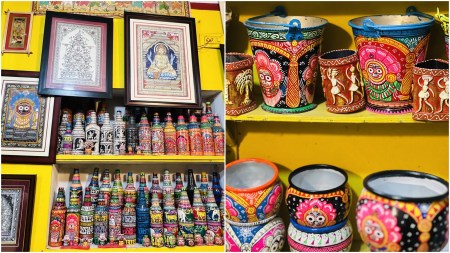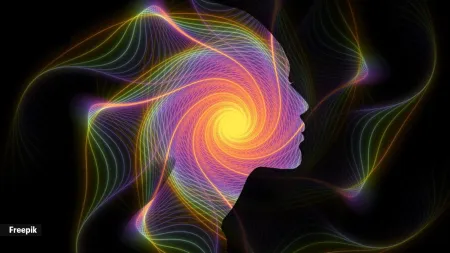Find Your Way: The India Art Fair Guide
For international art
Given that works of international artists are not regularly exhibited in galleries and museums in India, the IAF offers that occasional opportunity. On view, this year, is the monumental 320 x 1320 cm woma block work titled Water Lilies by Chinese dissident artist Ai Weiwei. At the neugerriemschneider booth, it draws from French painter Edouard Manet’s meticulously crafted gardens, and is the first viewing of this version by Ai Weiwei, rendered in vibrant colours for India. The Berlin-based gallery has juxtaposed it with Israeli artist, dance composer and notation specialist Noa Eshkol’s textile work Folk Dance with overlapping circular and semi-circular arcs, and Icelandic-Danish artist Olafur Eliasson’s Unseeing the Blind Spot in stainless steel. While Galleria Continua also has the Chinese artist’s works, the central wall at the booth has a stainless steel Anish Kapoor Magenta Pink and Red Wine satin that represents his engagement with colour. Also at the booth are Paris-based Eva Jospin’s silk thread embroidered intricate forests.
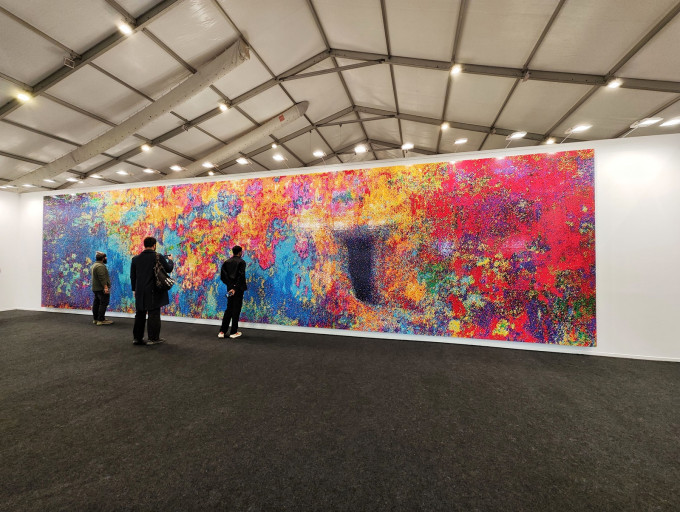 Water Lilies by Chinese dissident artist Ai Weiwei at the neugerriemschneider booth. (Express photo by Abhinav Saha)
Water Lilies by Chinese dissident artist Ai Weiwei at the neugerriemschneider booth. (Express photo by Abhinav Saha)
Making its debut at IAF, Galerie Geek Art from Japan has, among others, artist Kaneko Tomiyuki’s Great Tiger: Pacifier of Fire and Wind in mineral pigments, Japanese ink, transparent watercolour. As part of the launch of its Villa Swagatam residency programme, the French Institute in India, meanwhile, is presenting Franco-Cameroonian artist Barthélémy Toguo’s installation titled Water Matters, made in collaboration with artisans of the embroidery school Chanakya School of Craft and its creative director Karishma Swali. Contemporary Australian indigenous artist Sarrita King has a solo at the fair, and the Los Angeles County Museum of Art (LACMA) is presenting Irish artist John Gerrard’s digital work Western Flag (NFT) to reflect on the history of oil consumption in the US.

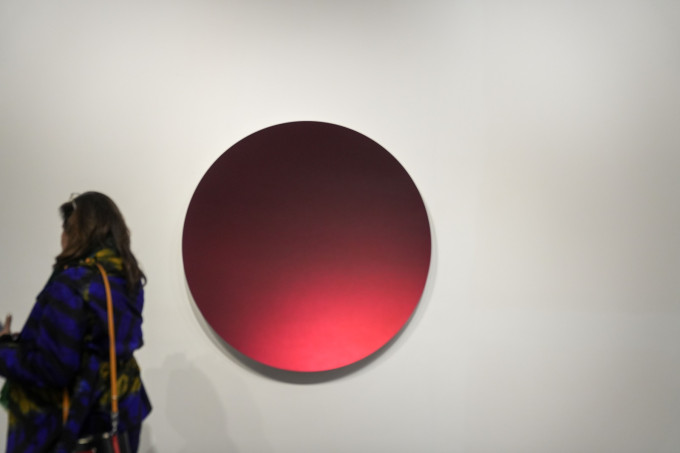 At Galleria Continua, Anish Kapoor’s Magenta Pink and Red Wine satin. (Express photo by Abhinav Saha)
At Galleria Continua, Anish Kapoor’s Magenta Pink and Red Wine satin. (Express photo by Abhinav Saha)
While Bruno Art Group has returned to the IAF with American artist Andy Warhol’s silkprints of Chinese leader Mao Zedong and American actress Marilyn Monroe, for its debut at the fair, Akara Contemporary from Akara has brought, among others, sculptures by Keita Miyazaki, who works between London and Tokyo, and brings together thought-provoking combinations of materials such as metal, fragile paper and felt.
If looking for modernists
Much like the art market in India, the modernists masters also dominate the art fair. The IAF has some of their more distinctive works. At Vadehra Art Gallery the 1999 Tyeb Mehta canvas titled Falling Bird recalls the associations the veteran artist’s falling figures and motifs had with his childhood recollections of violence that followed the Partition of the Indian subcontinent. If Grosvenor Gallery has, among others, FN Souza’s Ask Me Why?, a striking rendering of a male subject, at Art Heritage are works from Somnath Hore’s famed Wounds series. Gallerie Nvya has smaller pen and ink Jamini Roy works juxtaposed with a tempera of the Bengal artist depicting The Last Supper. Chawla Art Gallery is presenting as part of its booth paper works by MV Dhurandhar, KK Hebbar’s untitled portrait alongside Bhupen Khakar’s Kiss, and, also, works by Jamini Roy and Anjoli Ela Menon that can be read in braille.
 Jamini Roy’s tempera at Gallerie Nvya. (Courtesy: Gallerie Nvya)
Jamini Roy’s tempera at Gallerie Nvya. (Courtesy: Gallerie Nvya)
One of the oldest galleries of Delhi, Dhoomimal Gallery, has a 1948 watercolour by SH Raza, Jagdish Swaminathan’s Colour Geometry of Space, KH Ara still life and an Akbar Padamsee canvas. A bronze edition of one of the bigger Himmat Shah sculptures, Christ, also stands at the Dhoomimal booth, not too far from a MF mural in wood being presented by Crayon Art.
 MF Husain at DAG. (Express photo by Abhinav Saha)
MF Husain at DAG. (Express photo by Abhinav Saha)
Ganesh Haloi and Ram Kumar share space in a booth, and Art Exposure has a showcase of Jogen Chaudhury’s works that includes small drawings and a set of portraits sketched by him — among others of fellow artist Nalini Malani.
 Andy Warhol at Bruno Art. (Express photo by Abhinav Saha)
Andy Warhol at Bruno Art. (Express photo by Abhinav Saha)
At DAG, the curated showcase, “India Past and Present” explores the evolution of Indian art through the 18th to 21st centuries with works of modernists such as MF Husain, FN Souza and Krishen Khanna alongside Western artists who travelled to India, such as Thomas Daniell and Marius Bauer, and pre-modern artists. The highlights include Sewak Ram’s Muharram, R Regunatha Naidu’s Kaliya Daman and an MF Husian self-portrait.
Talking Points
With blurred letters on the fog-screen symbolic of forgotten histories, Jitish Kallat’s immersive installation titled Antumbra is a reflection on the passage of time and confinement. Premiering at IAF, the work gives a glimpse into desk calendars of South Africa’s first black president Nelson Mandela from his time in prison. Spanning 1976 to 1989, at several places, the pages remain blank, but in others there are notations of his blood pressure, records of recent dreams and prison visits. “There are some historical events that find mention, including Indian election results in 1980, but at the same time we find that some other historical events remain unmentioned, possibly because the news did not reach him or there could be deliberate omissions due to scrutiny,” says Kallat.
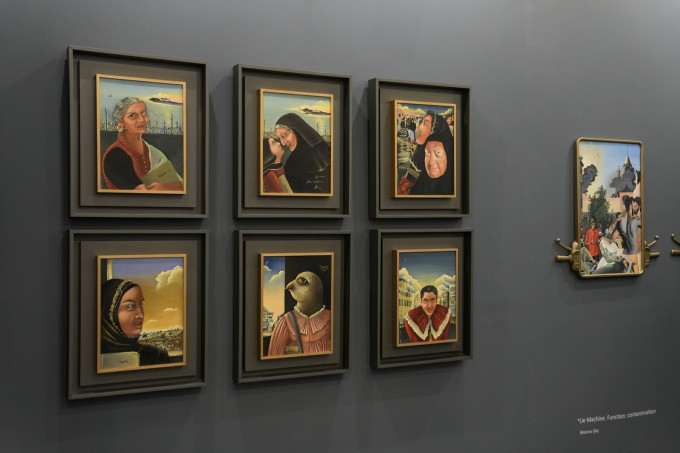 At Shrine Empire, Baaraan Ijlal’s set of works “I didn’t ask for fishbones: Notes on songs of abundance” (Express photo by Abhinav Saha)
At Shrine Empire, Baaraan Ijlal’s set of works “I didn’t ask for fishbones: Notes on songs of abundance” (Express photo by Abhinav Saha)
At Shrine Empire, Baaraan Ijlal’s set of works called “I didn’t ask for fishbones: Notes on songs of abundance” are fable-like portrayals and portraits on canvases that document testimonies of loss and suffering, taking forward her own engagement as witness and archiver of memories.
View this post on Instagram
A post shared by Baaraan Ijlal (@baaraanijlalstudio)
At Experimenter — that is presenting a group exhibition featuring 15 new commissions by 15 artists at the 15th edition of IAF — are Sahil Naik’s ceramic tile works from the series “Migrant flowers for postcolonial desires”, that continues his interest “in extracting patterns between the histories of colonisation, non-alignment and structures of Modern nation-building”. It delves into the history of flowering trees brought to India by the colonisers and the new architectural lexicon post-Independence.
If the Anant Art booth has a set of works by Gulammohammed Sheikh that engage with the politics of language by creating complex three-dimensional forms out of Urdu and Persian letters carved out of books and pasted on wasli paper, at Vadehra Art Gallery are Atul Dodiya cabinets that occupy different elements and objects to tell a story.
In the Studio section, interdisciplinary hearing-impaired artist Janhavi Khemka is sharing her experiences and observations through stop-motion animations developed from woodcut prints that come together under the title “Waiting for Dawn”. If A Letter to My Mother has animated patterns of lips in woodcut, reminiscent of the mat on which her mother first taught her to lip read, Siri’s Here to Help brings forth the absurdities of miscommunication. At the booth, she was discussing her life and art with the viewers.
Woven narratives
Several works in textile are making an impression at the fair — some for their handwork, others for the subjects they depict. At Shrine Empire, Bengaluru-based artist Renuka Rajiv’s Cushion Cover Myopia/ Armchair Inaction has interwoven squares in fabric and thread, with statements as lead-ins for the viewers. Shivani Aggarwal’s set of 10 works, Holding Nothingness, at Studio Art reflects on what is known and what is not, and T Venkanna’s Strong Desire at Gallery Maskara has a man dying “while his living partner struggles on for connection”. Anup Mehta Contemporary has Sarika Bajaj’s meticulously woven feathers and threads on jute works, and at Gallerie Splash there is Akshata Mokashi’s tapestry where weaving is influenced by the medieval tapestries of Europe and Indian rugs. Known to respond to his socio-political surroundings, Bangladeshi artist Mahbubur Rahman’s silk embroidery artwork from the series “The Heroes”, including a portrait of Princess Sophia Duleep Singh, are showing at Blueprint 12.
View this post on Instagram
A post shared by Gallery Espace (@galleryespace)
Gallery Espace has a sizable number of works in textile — including a Paula Sengupta work and Puneet Kaushik’s From the Dohar Series in deep red. At the booth, for her delicate and soothing chikankari on cloth titled Basant Bahaar, Manisha Gera Baswani has worked with embroiderers in Lucknow.
Not by the artists themselves, but Mash is presenting embroidered renderings of some of the acclaimed works by artists such as KK Hebbar, Nilima Sheikh and SH Raza.
Also becoming stops
Dressed in gold, visual artist Tito Stanley was the protagonist from his canvas, The Fire and the Death, being shown at IAF — drawing several visitors to pose for photographs with him. Others were queuing at Bengaluru-based Shilo Shiv Suleman’s immersive space at Art Musings booth that features her body of work “God is a Woman in Love”, representing eight Ashtanayikas in as archetypal romantic heroines.
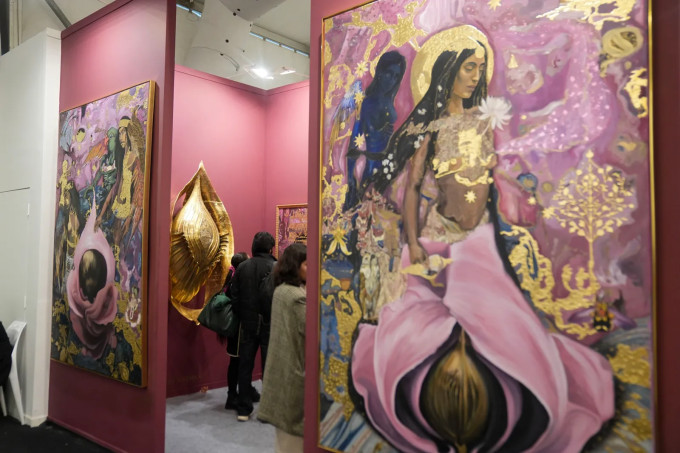 Shilo Shiv Suleman’s immersive space at Art Musings. (Express photo by Abhinav Saha)
Shilo Shiv Suleman’s immersive space at Art Musings. (Express photo by Abhinav Saha)
At some places, people don’t mind being followed — as is evident by those walking past Sajid Wajid Shaikh’s outdoor installation Deewaron Ke Bhi Kaan hote Hain, where kinetic ears follow viewers, in a work that scrutinises surveillance. Also outdoors is Doyel Joshi and Neil Ghose Balser’s ice installation that is melting away, and Shovin Bhattacharjee’s kinetic Cosmic Eye that seems to be gazing at the viewers. Several ceramic artists have come together to celebrate the medium in Clay in Common.
 Sajid Wajid Shaikh’s outdoor installation Deewaron Ke Bhi Kaan hote Hain. (Express photo by Abhinav Saha)
Sajid Wajid Shaikh’s outdoor installation Deewaron Ke Bhi Kaan hote Hain. (Express photo by Abhinav Saha)
If LN Tallur’s sculpture in bronze at Chemould Prescott Road has a Nataraja to comment on AI, at Latitude 28 is Sudipta Das’s Journey Uncontained that represents the hard lives of the migrants. Also at Latitude 28, Yogesh Ramkrishna compares the political yatras to the Pandharpur yatra in Maharashtra in Some Journeys are Beautiful but Going Away is Hard. “The everyday issues are forgotten temporarily,” says Ramkrishna.
While some viewers are travelling through social stratas across India in Gigi Scaria’s Elevator to the Subcontinent, at Gallery Ske artist Madhukar Mucharla has miniature kolhapuri chappals on stone in a work that reflects on caste discrimination. Hailing from Nandi Wanaparthy, a village in the outskirts of Hyderabad, he belongs to the Madiga community that is traditionally associated with leather work and tannery.
Delhi-based artist Veer Munshi is recalling the dying traditions and crafts of his homeland Kashmir through a solo presentation of his recent works titled “Healing Wounds” within the Aicon booth, and at Palette Art Narayan Biswas is paying homage to his father, who was a carpenter, through metal works in architectural designs created with a wooden finish.
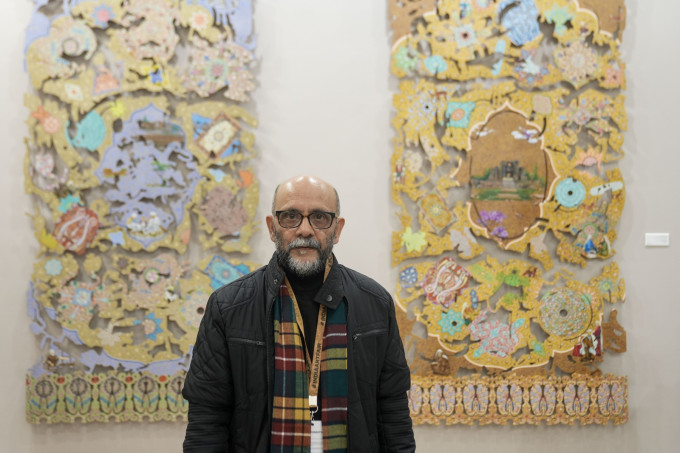 Veer Munshi with his works at Aicon. (Express photo by Abhinav Saha)
Veer Munshi with his works at Aicon. (Express photo by Abhinav Saha)
The water bodies of Chilika lake in Odisha act as conceptual ground for Pinaki Ranjan Mohanty’s Territorial Sublime at Art Centrix Space, and at Art Alive is Paresh Maity 116×180 inch Enlightened City. The artist is also exhibiting his 16-ft long Rhythmic Resonance: A Visual Raga within a painted enclosure, with mridangam as the symbolic focal point to contemplate on shared human experiences through music.
In a showcase curated by Vishal Dar, the CP Kukreja Foundation for Design Excellence is presenting an exhibition on the making of Delhi’s Jawaharlal Nehru University.
Photography as their medium
A solo presentation of Dayanita Singh’s works features in “house museums” with prints on forte paper that hold different themes, from chairs to Mumbai cinema halls. While Photoink is paying tribute to late modernist Vivan Sundaram, placing his photographs alongside those of his grandfather Umrao Singh Sher-Gil, the booth also has Madan Mahatta’s industrial photographs from the 1970s, and Madhuban Mitra and Manas Bhattacharya reflecting on the impact of AI on portraiture. At Vadehra gallery, Gauri Gill is sharing works from different series, including the ongoing series Acts of Appearance that germinates from her encounters with a village of Adivasi paper mache artists in Maharashtra, and Mark on the Wall that documents drawings made as part of the now lapsed Leher Kaksha scheme. Wonderwall, meanwhile, has one photograph each by S Paul and Prabuddha Dasgupta, among others.
View this post on Instagram
A post shared by Dayanita singh studio (@dayanitasingh)
At Art Heritage, German cinematographer Joseph Wirsching’s photographs of the film studio Bombay Talkies from the 1930s are telling of Indian cinema at the time.
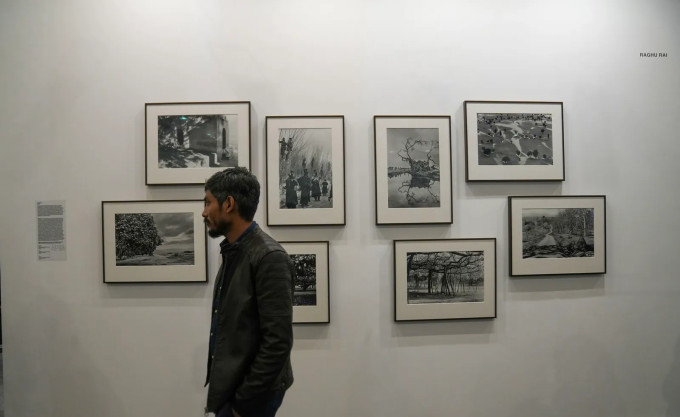 At Photoink, Raghu Rai’s photographs from the “Trees” Series. (Express photo by Abhinav Saha)
At Photoink, Raghu Rai’s photographs from the “Trees” Series. (Express photo by Abhinav Saha)
Design Launch
The IAF has launched a limited edition and collectible design section with seven design studios as participants this year — including Vikram Goyal, Atelier Ashiesh Shah, Gunjan Gupta, Rooshad Shroff, Studio Renn, de Gournay, and Karishma Swali & Chanakya School of Craft. The segment has also brought in design galleries ÆQUŌ and Carpenters Workshop Gallery. A celebrated name in design, the latter boasts, among others, works by the likes of Wendell Castle, Nacho Carbonell, Ingrid Donat and Karl Lagerfeld.
Rooted in Tradition
 Bhutanese thangka paintings that feature in “The Wheel of Life”
Bhutanese thangka paintings that feature in “The Wheel of Life”
Presented by Serenity Arts, “The Wheel of Life” comprises Bhutanese thangka paintings by artist Zeikor and his team. Among the deities represented are Dhakinis, Goddesses of Offerings; Zambala, God of Wealth; and Goddess of Wealth & Protection, Dem Kuru. Inherited Arts Forum is making a curated presentation on the artistic trope of ‘Devi and her vahana’ with paintings and sculptures and Shrujan – Living and Learning Design Centre is presenting contemporary crafts from Kutch. Delhi Crafts Council is exhibiting traditional woodworking technique of marquetry in varied themes, and Ojas is presenting works by a group of ten artists working across different genres, including Gond artist Bhajju Shyam and Bhil artist Lado Bai. Gallery Ragini has Jatin Singh’s works in monochrome, S Srinivas Rao’s floral depictions, pichvais by KM Singh, and Riaan and Najish Khan’s depictions of scenes from the Mahabharata woven on wall carpets.
 KM Singh’s pichwai at Gallery Ragini. (Courtesy: Gallery Ragini)
KM Singh’s pichwai at Gallery Ragini. (Courtesy: Gallery Ragini)
Performance as Art
On February 3, 1 to 4 pm, in Exercises in Belonging: Laterite Moorings, artist Jyothidas KV will stage adapted rituals, invoking hillocks of porous red rocks and imaginary vessels to “draw lores of human bodies and cash crops, right out of the mountains of the Western Ghats”. Kerala-born, Berlin-based artist Sajan Mani’s performance on February 4, 12 to 3 pm, will be inspired by the ritualistic dances of lower caste communities in Dravidian traditions in which human bodies ceremonially transform into those of gods.
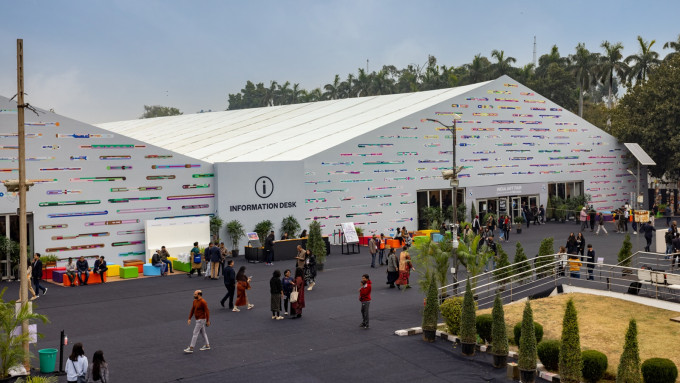 The India Art Fair Grounds (Courtesy: India Art Fair)
The India Art Fair Grounds (Courtesy: India Art Fair)
Be part of the gameplay
Some artworks intend for the viewers to be creators and decision-makers. The designers of the tent facade at IAF this year, artists Jiten Thukral and Sumir Tagra are also inviting audiences to create their own stories in the digital world by allowing them to choose from a selection of over 70,000 words that relate to ‘Forces of Nature’. The algorithm subsequently generates a custom digital artwork with the artist duo’s motifs transforming the words into a digital tapestry in varied colours and patterns — the final creations are being digitally shared with the creators. At another booth, also being shared are portraits drawn by participants in the Procreate app on iPad during a 60-minute session.
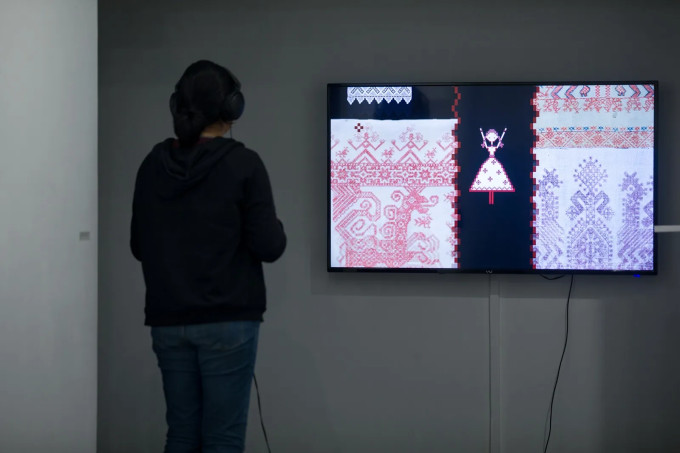 Afrah Shafiq’s The Bride Who Could Not Stop Crying . (Courtesy: Experimenter)
Afrah Shafiq’s The Bride Who Could Not Stop Crying . (Courtesy: Experimenter)
At the Experimenter booth, Afrah Shafiq is inviting audiences to play a game in The Bride Who Could Not Stop Crying, warning early-on that the choices they make will determine how much she cries. Dhruv Jain, on the other hand, is asking them to navigate narrow paths in a game where they confront buried histories and lost landscapes. If Sadhna Prasad’s digital work allows viewers to explore nature’s hierarchies using an iPad, at Method they can experience an immersive installation that incorporates principles of colour psychology and emotional mapping to respond to the participants’ rhythms of heart and breath to reflect the colours around them.
In “Orinthoscope”, digital artists in residence, Myles and Ameya, are presenting an immersive audiovisual piece that maps two decades of birdsong across the Indian subcontinent — choose your state and year. The learnings might disappoint though — as both the perching sounds and sightings of birds have dwindled over the years.
Being led at the fair
Navigating so much art can be daunting. For those who prefer for someone to escort them around the fair and help them read art are several curated tours being conducted through the day. While independent researcher, educator and curator Shaleen Wadhwana is taking visitors through select highlights at IAF, the tour “Green Conscious” highlights key works that respond to our ecological and climate crises.
“Art History 101” discusses the living artistic traditions of South Asia, and “Art of the Possible” engages “with artworks that showcase the everyday reality of social difference through lenses ranging from queerness to caste”.
In a first, the fair also has art tours designed for children — from teaching them empathy through an art walk or, in another walk, teaching them to be conscious of ecological concerns. For more details on art tours and timings, log on: https://indiaartfair.in.
Taking place at NSIC Grounds in Okhla, India Art Fair is on till February 4. Closest metro station: Govindpuri. Tickets are available on bookmyshow.com
Disclaimer: The copyright of this article belongs to the original author. Reposting this article is solely for the purpose of information dissemination and does not constitute any investment advice. If there is any infringement, please contact us immediately. We will make corrections or deletions as necessary. Thank you.



